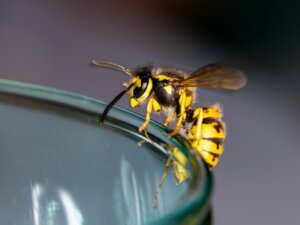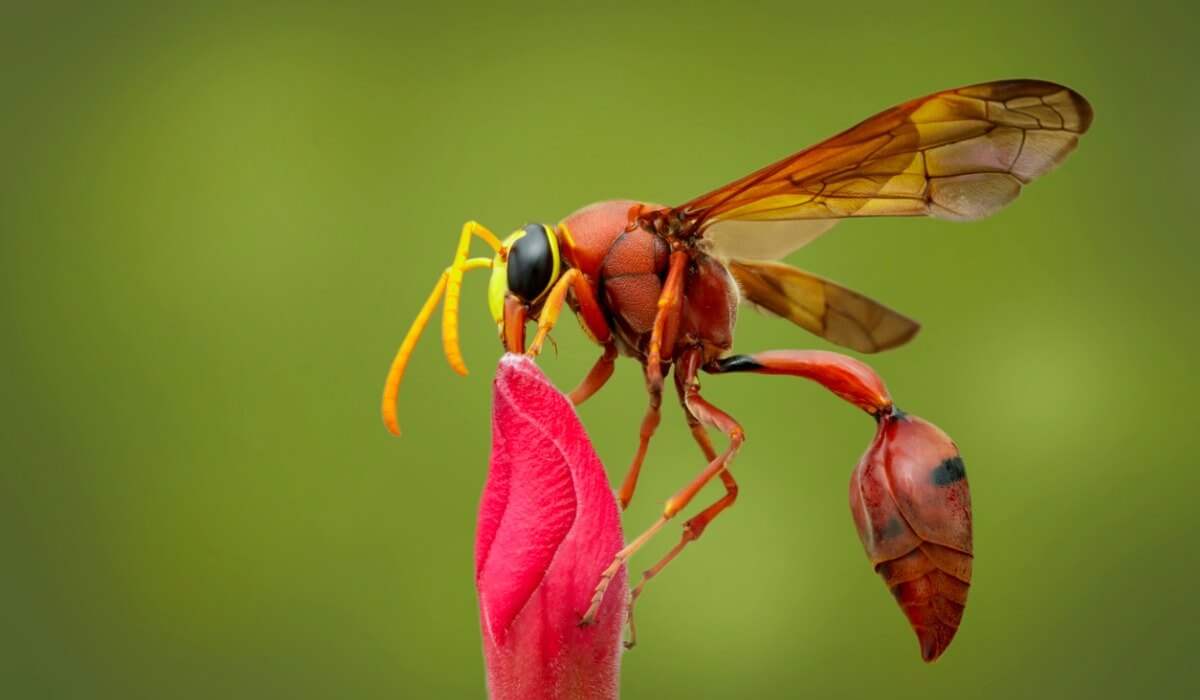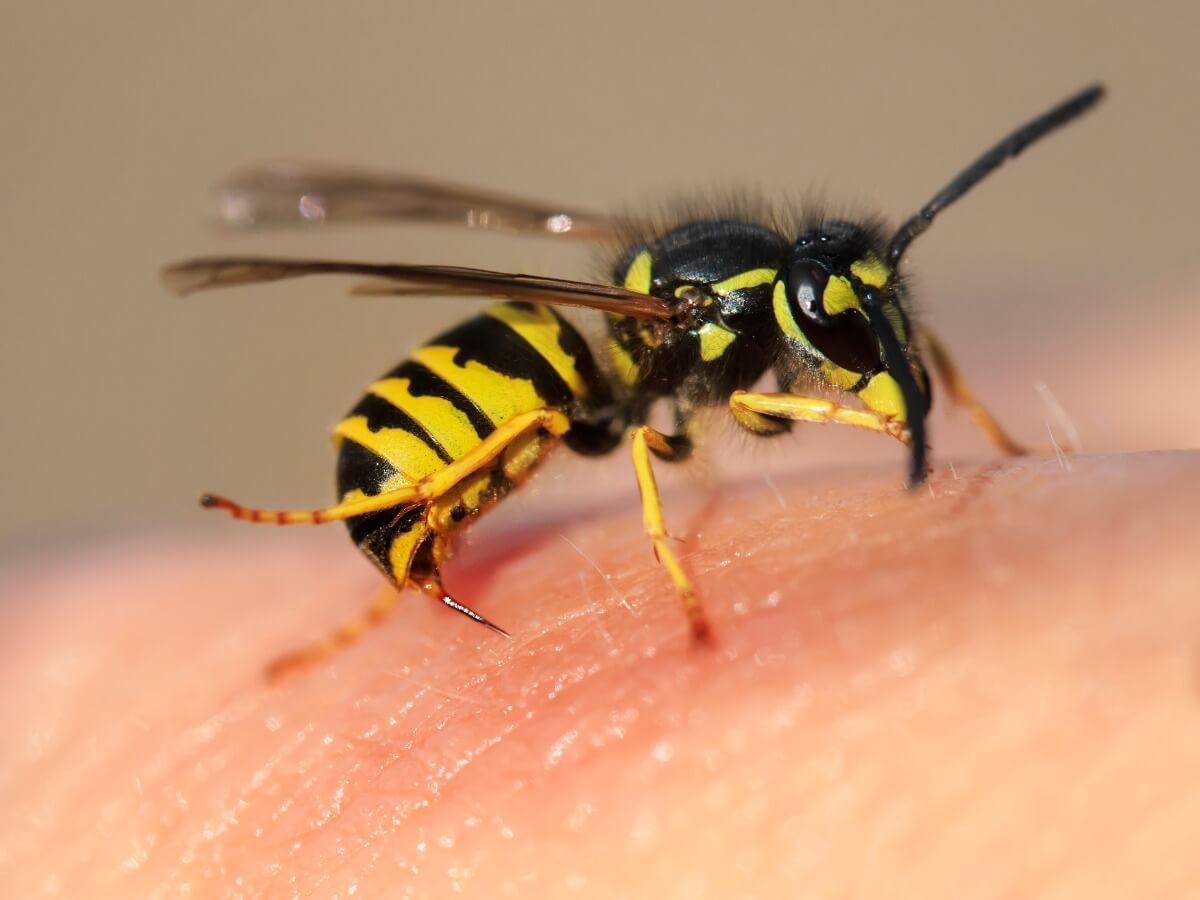10 Curiosities About Wasps


Written and verified by the biologist Samuel Sanchez
There are many curiosities about wasps, but, unfortunately, many people don’t want to know about them! One of the most common species in our towns, they have earned their bad reputation for many reasons. They interrupt meals in the open air, they build their nests near our homes, and their sting can often cause pain and complications.
Although they don’t coexist well with humans, wasps undoubtedly deserve recognition for their fascinating makeup and their invaluable work in ecosystems. Give these hymenopterans a chance, and read our 10 curiosities about wasps that, we hope, will make you appreciate them a little more (from a distance!)
1. Curiosities about wasps: their diversity is endless
As indicated by the National Geographic magazine, to date more than 30,000 species of wasps have been described, reaching an estimated 100,000 in recent times. The calculated figure of global diversity is even higher, as there are many specimens still to be classified and discovered, especially in tropical and temperate areas.
Without a doubt, these invertebrates represent some of the largest and most diverse groups of hexapods in the world.
2. They’re hymenopterans, the same as bees and ants
Wasps belong to the order Hymenoptera, along with bees and ants. All of them have a number of common features: a rounded head with antennae, prominent jaws, compound eyes and ocelli, a thorax in with 3 pairs of walking legs, and a highly visible abdomen, which may (or may not) contain a stinger in the case of females.
If you have trouble distinguishing a bee from an ant or a wasp, here’s a simple key:
- Queen ants are winged, but the wings fall off once they fertilize and found the colony. On the other hand, wasps are characterized by having wings and flying habits throughout their lives, with the exception of the Mutilidae family. Ant workers are wingless at all times.
- Bees have a plump and compact body, while wasps have a distinct “waist” or petiole, which joins segments 1 and 2 of the abdomen.
- Wasps tend to have more striking colors than ants and bees. However, there’s such a variety of hues in this group that the eye can be deceiving.

3. A cosmopolitan habitat
Wasps have colonized every continent and land in the world, except Antarctica. Being ectothermic (cold-blooded) animals, they depend on the external temperature to regulate their metabolism. Therefore, they don’t adapt well to extremely cold environments, such as those present in polar circles.
4. Social and solitary animals
Another curiosity about wasps is that some are eusocial, although the vast majority exhibit solitary behaviors. Of the more than 30,000 species described, only the family Vespidae (with more than 5,000 representatives) adopts the typical social model of Hymenoptera, with combs, queens, and males divided into castes.
Although the best-known wasps are social, the vast majority of representatives of this group lead a very lonely life. They devote their existence to reproducing and taking care of their offspring in the nest they build, but they do so individually and without the help of other specimens of the same species. They’re the complete opposite of ants and their vital strategies.
5. An intricate sex determination system
Wasps, like ants and bees, have their sex determined by a haplodiploid mechanism. Females are diploid (2n), which means that they have two sets of homologous chromosomes in each of their cells. In other words, a female wasp is the product of fertilization and reproduction between parents (n + n = 2n).
On the other hand, males or drones are haploid (n), which means that they come from unfertilized eggs. As the laying female stores her partner’s semen in her body, if she wants to give birth to a male, she simply stops fertilizing one of the eggs. Males, carrying half the genetic information, don’t live as long, and their physiology is limited.
6. Not all wasps sting
Within the Hymenoptera, some families form a specific group, called Aculeata. All the species included here have a common characteristic: the female ovipositor has been modified to give rise to a stinger, capable of injecting different toxins with common characteristics of the taxon (aculeatoxins).
Another curiosity about wasps is that, according to this simple rule, males can never sting. They don’t have a mechanism to lay eggs, so it hasn’t been able to develop a stinger capable of injecting poison. If you get stung by one of these winged Hymenopterans, you can be sure it’s a female.
Ants and bees also have stingers, or, rather, modified ovipositors to enable them to sting.

7. A diet that changes throughout life
Most solitary wasps feed on flower nectar, but they constantly require protein and look for it in live or dead insects. But why do they do it, if they themselves cover their dietary requirements with the sugars produced by plants?
The answer is found in the larvae. As the worm-shaped offspring of wasps require a constant protein supply to grow and metamorphose into adults, their mother (or workers in social species) must continually search for organic matter of animal origin. Females even chew the organic matter before offering it to their offspring.
8. Necessary killers for ecosystems
The wasps of the Vespidae, Crabronidae, Sphecidae and Pompilidae groups are active hunters, as they inoculate the venom with their stinger on their prey, render it useless and take it to the nest, where they ingest it and feed their larvae. The pollinating work of these hymenopterans isn’t as great as many believe, but they are excellent controllers of insect pests and other invertebrates.
As they don’t have hairs on their bodies (unlike bees), pollen doesn’t stick well to their bodies and they don’t fertilize flowers effectively.
9. Parasitoid wasps: a living nightmare
The curiosities regarding parasitoid wasps deserve a whole article just for them, but we can’t finish without mentioning them. Specifically, the tarantula hawks, of the Pompilidae family, have one of the most terrifying life strategies that you could imagine.
Thanks to their extremely powerful venom, these wasps face up to tarantulas much larger than themselves, paralyzing them as soon as they get the chance. After that, they take their prey to the nest and lay a single egg on its abdomen. The newly hatched larva enters the body of the tarantula and feeds on it while it’s still living (even though it can’t move).
The larva pupates within the tarantula and emerges from its abdomen as a formed individual.
10. Insects you can live with
So, what did you think of this list? As the last of our curiosities about wasps, we want to emphasize that their venom isn’t life threatening, unless the person is allergic and receives multiple stings. In addition, a group of them will only attack when someone is trying to destroy the nest or kill the offspring, so it’s always possible to avoid confrontations.
Wasps aren’t pests, as they don’t destroy agricultural crops or kill plants. They can simply be a bit annoying because of their potential sting and presence around food, but we should all apply the same rule in these cases: if we leave them alone, they won’t have a reason to attack us.
There are many curiosities about wasps, but, unfortunately, many people don’t want to know about them! One of the most common species in our towns, they have earned their bad reputation for many reasons. They interrupt meals in the open air, they build their nests near our homes, and their sting can often cause pain and complications.
Although they don’t coexist well with humans, wasps undoubtedly deserve recognition for their fascinating makeup and their invaluable work in ecosystems. Give these hymenopterans a chance, and read our 10 curiosities about wasps that, we hope, will make you appreciate them a little more (from a distance!)
1. Curiosities about wasps: their diversity is endless
As indicated by the National Geographic magazine, to date more than 30,000 species of wasps have been described, reaching an estimated 100,000 in recent times. The calculated figure of global diversity is even higher, as there are many specimens still to be classified and discovered, especially in tropical and temperate areas.
Without a doubt, these invertebrates represent some of the largest and most diverse groups of hexapods in the world.
2. They’re hymenopterans, the same as bees and ants
Wasps belong to the order Hymenoptera, along with bees and ants. All of them have a number of common features: a rounded head with antennae, prominent jaws, compound eyes and ocelli, a thorax in with 3 pairs of walking legs, and a highly visible abdomen, which may (or may not) contain a stinger in the case of females.
If you have trouble distinguishing a bee from an ant or a wasp, here’s a simple key:
- Queen ants are winged, but the wings fall off once they fertilize and found the colony. On the other hand, wasps are characterized by having wings and flying habits throughout their lives, with the exception of the Mutilidae family. Ant workers are wingless at all times.
- Bees have a plump and compact body, while wasps have a distinct “waist” or petiole, which joins segments 1 and 2 of the abdomen.
- Wasps tend to have more striking colors than ants and bees. However, there’s such a variety of hues in this group that the eye can be deceiving.

3. A cosmopolitan habitat
Wasps have colonized every continent and land in the world, except Antarctica. Being ectothermic (cold-blooded) animals, they depend on the external temperature to regulate their metabolism. Therefore, they don’t adapt well to extremely cold environments, such as those present in polar circles.
4. Social and solitary animals
Another curiosity about wasps is that some are eusocial, although the vast majority exhibit solitary behaviors. Of the more than 30,000 species described, only the family Vespidae (with more than 5,000 representatives) adopts the typical social model of Hymenoptera, with combs, queens, and males divided into castes.
Although the best-known wasps are social, the vast majority of representatives of this group lead a very lonely life. They devote their existence to reproducing and taking care of their offspring in the nest they build, but they do so individually and without the help of other specimens of the same species. They’re the complete opposite of ants and their vital strategies.
5. An intricate sex determination system
Wasps, like ants and bees, have their sex determined by a haplodiploid mechanism. Females are diploid (2n), which means that they have two sets of homologous chromosomes in each of their cells. In other words, a female wasp is the product of fertilization and reproduction between parents (n + n = 2n).
On the other hand, males or drones are haploid (n), which means that they come from unfertilized eggs. As the laying female stores her partner’s semen in her body, if she wants to give birth to a male, she simply stops fertilizing one of the eggs. Males, carrying half the genetic information, don’t live as long, and their physiology is limited.
6. Not all wasps sting
Within the Hymenoptera, some families form a specific group, called Aculeata. All the species included here have a common characteristic: the female ovipositor has been modified to give rise to a stinger, capable of injecting different toxins with common characteristics of the taxon (aculeatoxins).
Another curiosity about wasps is that, according to this simple rule, males can never sting. They don’t have a mechanism to lay eggs, so it hasn’t been able to develop a stinger capable of injecting poison. If you get stung by one of these winged Hymenopterans, you can be sure it’s a female.
Ants and bees also have stingers, or, rather, modified ovipositors to enable them to sting.

7. A diet that changes throughout life
Most solitary wasps feed on flower nectar, but they constantly require protein and look for it in live or dead insects. But why do they do it, if they themselves cover their dietary requirements with the sugars produced by plants?
The answer is found in the larvae. As the worm-shaped offspring of wasps require a constant protein supply to grow and metamorphose into adults, their mother (or workers in social species) must continually search for organic matter of animal origin. Females even chew the organic matter before offering it to their offspring.
8. Necessary killers for ecosystems
The wasps of the Vespidae, Crabronidae, Sphecidae and Pompilidae groups are active hunters, as they inoculate the venom with their stinger on their prey, render it useless and take it to the nest, where they ingest it and feed their larvae. The pollinating work of these hymenopterans isn’t as great as many believe, but they are excellent controllers of insect pests and other invertebrates.
As they don’t have hairs on their bodies (unlike bees), pollen doesn’t stick well to their bodies and they don’t fertilize flowers effectively.
9. Parasitoid wasps: a living nightmare
The curiosities regarding parasitoid wasps deserve a whole article just for them, but we can’t finish without mentioning them. Specifically, the tarantula hawks, of the Pompilidae family, have one of the most terrifying life strategies that you could imagine.
Thanks to their extremely powerful venom, these wasps face up to tarantulas much larger than themselves, paralyzing them as soon as they get the chance. After that, they take their prey to the nest and lay a single egg on its abdomen. The newly hatched larva enters the body of the tarantula and feeds on it while it’s still living (even though it can’t move).
The larva pupates within the tarantula and emerges from its abdomen as a formed individual.
10. Insects you can live with
So, what did you think of this list? As the last of our curiosities about wasps, we want to emphasize that their venom isn’t life threatening, unless the person is allergic and receives multiple stings. In addition, a group of them will only attack when someone is trying to destroy the nest or kill the offspring, so it’s always possible to avoid confrontations.
Wasps aren’t pests, as they don’t destroy agricultural crops or kill plants. They can simply be a bit annoying because of their potential sting and presence around food, but we should all apply the same rule in these cases: if we leave them alone, they won’t have a reason to attack us.
All cited sources were thoroughly reviewed by our team to ensure their quality, reliability, currency, and validity. The bibliography of this article was considered reliable and of academic or scientific accuracy.
- Thomas, C. R. (1960). The European wasp (Vespula germanica Fab.) in New Zealand. The European wasp (Vespula germánica Fab.) in New Zealand., (27).
- Archer, M. E. (1985). Population dynamics of the social wasps Vespula vulgaris and Vespula germanica in England. The Journal of Animal Ecology, 473-485.
- Landolt, P. J. (1998). Chemical attractants for trapping yellowjackets Vespula germanica and Vespula pensylvanica (Hymenoptera: Vespidae). Environmental Entomology, 27(5), 1229-1234.
- Wasps, National Geographic. Recogido a 16 de agosto en https://www.nationalgeographic.com/animals/invertebrates/facts/wasps
This text is provided for informational purposes only and does not replace consultation with a professional. If in doubt, consult your specialist.








